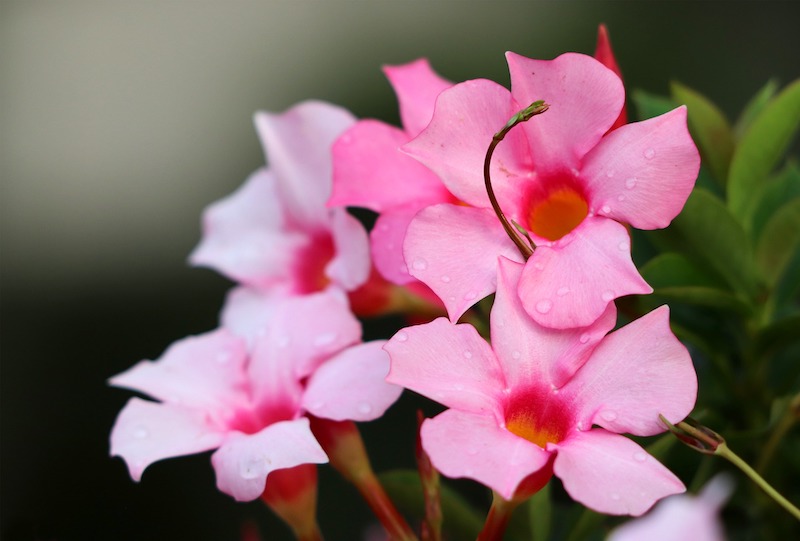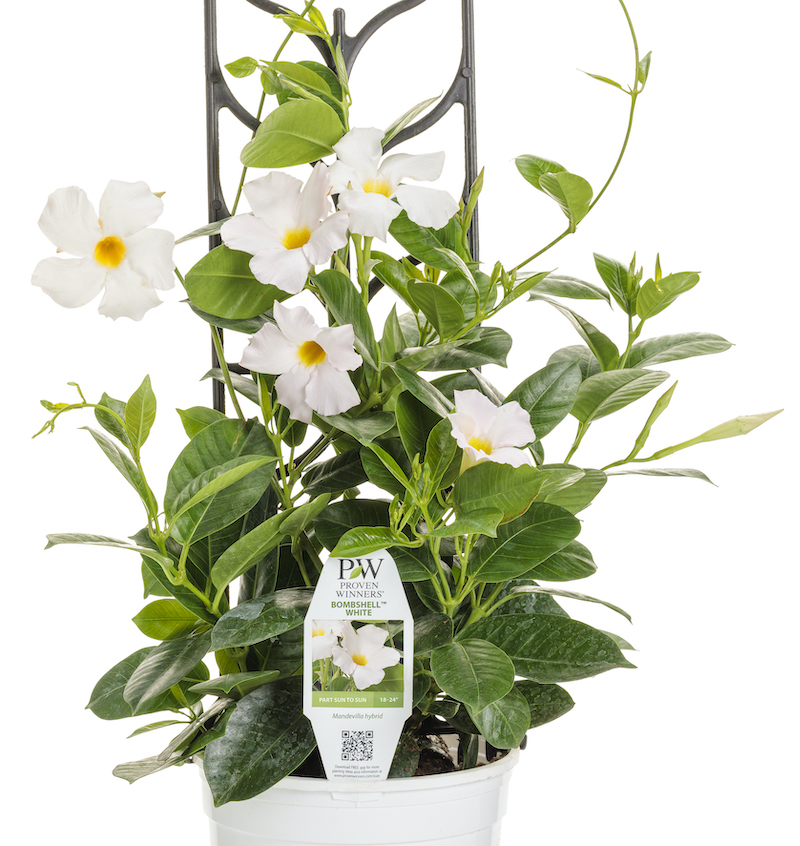Growing Mandevilla
Mandevilla is a flowering vine also known as rock trumpet. This plant boasts showy 5-petaled flowers in shades of red, pink, and yellow that give an outdoor space a tropical vibe. The flowers bloom during the summer and fall and are offset by glossy green foliage. The reaching vines make this plant a striking addition to a hanging basket or a focal point for a trellis that the vines can grow and climb.
Mandevilla is a fast-growing plant that is also easy to maintain. Depending on the variety, the vines can reach up to 10 feet long, and the plant can be up to 4 feet wide. This beauty grows as a perennial in tropical and subtropical climates and is commonly grown as an annual in other areas.

Planting Mandevilla
Mandevilla needs rich, moist, well-drained soil with a neutral to acidic pH. Plant in a sunny area that receives at least 6 hours of sunlight daily, but be mindful of the intense afternoon sun, which may be more than Mandevilla can handle. This tropical plant will thrive with warm temperatures and increased humidity.
Watering Mandevilla
This vining plant prefers consistently damp soil, but it does not like to sit in standing water. Give Mandevilla a drink when the top inch of soil feels damp but not wet. Spray the foliage with water to increase the dampness and humidity. Mandevilla is somewhat drought-tolerant and can handle a bit of dryness, but continued dryness can be damaging.

Fertilizing Mandevilla
Routine fertilization will help this fast-growing vine reach its full potential and continue to push out lovely blooms. A balanced fertilizer with an NPK ratio of 10-10-10 or 20-20-20 supports healthy growth. Use a granular slow-release fertilizer once in the spring to support growth throughout the growing season. Another option is to apply a water-soluble fertilizer every couple of weeks.
Pruning Mandevilla
The vines are a big draw for Mandevilla but trim the vines back to maintain a more compact and bushy appearance. This beauty blooms on new growth, so in warm climates, shape the plant as necessary in the fall or early spring before new growth emerges. Cut back no more than one-third of the plant at a time. Remove dead or damaged growth at any time, and all growth can be trimmed back in the fall in areas with cold winter weather. Deadheading is unnecessary, but removing spent flowers will keep the plant looking clean and tidy.
Caring For Mandevilla in Pots
Mandevilla is a good choice for containers for areas outside its hardiness rating, where you can grow this tropical stunner outdoors on a porch or patio. Water daily or when the top layer of the soil feels damp. The container must have drainage so excess water can run through the pot. Amend the soil with organic compost and fertilize using a water-soluble fertilizer every couple of weeks.

Winter Care for Mandevilla
Mandevilla can be left without any additional winter care in areas with mild winters. This plant may continue to grow in warm winter weather, but cover Mandevilla in the event of a cold snap. Trim the growth back to a few inches above the ground in the fall when grown in areas with cold winters. Depending on the weather, potted Mandevilla plants should be moved to a protected area during the winter.
Common Care Questions About Mandevilla
Is Mandevilla An Annual or Perennial?
Mandevilla is a tropical plant that grows as a perennial in very warm climates and is grown as an annual everywhere else.
How Much Water Does Mandevilla Need?
Water at the base of the plant. Mandevilla can be watered on a daily basis- about 30 seconds to 1 minute of a steady stream. Or can be watered 1 to 2x .
Mandevilla Winter Care
https://plantaddicts.com/mandevilla-winter-care/
How Long Do Mandevillas Bloom Last?
Usually bloom in early summer and the Mandevilla bloom period lasts until the first frost in autumn.
What Is The Growth Rate Of Mandevilla?
Mandevilla plants are fast growers and can reach heights of up to 10 feet in a single season.
Can Mandevilla Be Grown Indoors?
They can be grown indoors in a bright location but out of direct sunlight. Mandevilla may take some space though.
Mandevilla In Pots
Growing Mandevilla in pots is easy. They are fast-growing plants and need to be repotted annually.
Are Mandevilla Poisonous?
All parts of Mandevilla plants are poisonous if eaten, so keep this vining plant out of the reach of children.
Are Mandevilla Deer Resistant?
Mandevilla is generally considered deer resistant, making it a good choice for areas with large deer populations.
Are Mandevilla Invasive?
Mandevilla are not considered invasive, but can grow to be invasive if they are not managed and maintained properly.
Mandevilla Isn't Blooming
If there are no Mandevilla flowers on your plant, the cause could be cultural, improper site conditions, or temperatures that are too cool. Full sun to filtered sunlight is an important key to continuing blooming. They will not bloom in a shaded environment. To get the best blooms all summer long, use a “Bloom Booster” fertilizer once every other week.
Why Are Mandevilla Leaves Turning Yellow, Brown, and/or Black?
Too much or too little water can be the reason for the leaves to turn yellow or brown. Mandevilla thrives in moist soil.
Have a question about Mandevilla? Fill out the form below and we will try and get back to your question as soon as possible. We may even feature your question in this article to help other gardeners!
 |
Author Alison Cotsonas - Published 30-08-2022 |
